- Know Who is a Sikh? Who are Amritdhari/Keshdhari Sikhs? Why did Ambedkar not become a Sikh? How Jaats became a powerful community in Punjab? Who is a Bhapa & are Brahmin Sikhs? Who are Nirmalas, Udasis and Nirankaris? Who are Scheduled Caste Sikhs? Why are Deras popular?
In the run up to the Punjab state elections was a viral video by senior journalist Shekhar Gupta on castes within Sikh community. An earlier article stated that former Chief Minister of Punjab Charanjit S Channi belonged to the Chamar community (of Ramdasia Sikhs). The last CM from the depressed classes (name used by Ambedkar) was Giani Zail Singh who belonged to the carpenter community (of Ramagariya Sikhs). The video goaded me into writing this essay. Thanks Shekhar.
1. The Caste Construct
Many of us are obsessed with caste. We shall
debate whether Shivaji Maharaj was a Sudra or Kshatriya but not his karmas. Read Shivaji’s
Karmas not caste matter
Is the word caste Indian in origin? No it is of Spanish
origin and fails to capture the meaning of the Indian term “jati,” which more properly translates as
“community.” Jati in traditional India promoted and preserved diversity and
multiculturalism by allotting every jati a particular space and role in society
so that no jati would be appropriated or dominated by another. The jati system
was integral to the survival of the Indian nation.
Note what
Dharampal wrote in Rediscovering
India, “For the British, as perhaps for some others before
them, caste has been a great obstacle, in fact, an unmitigated evil not because
the British believed in casteless-ness or subscribed to a non-hierarchical
system but because it stood in the way of their breaking Indian society,
hindered the process of atomisation, & made the task of conquest &
governance more difficult.”
Further, Swami Vivekananda said, “Caste is an imperfect institution, no doubt. But if it had not been for caste, you would have had no Sanskrit books to study. This caste made walls, around which all sorts of invasions rolled and surged but found it impossible to break through.”
Having said that, the Varna system has degenerated over the years.
Note that Abbe J.A. Dubois, a Christian missionary of eminence, who was in India from 1792 to 1823 wrote thus, “This plan of dividing the people of India into castes is not confined to the law givers of India.” 4 Hinduism: The Faith Eternal Pg. 66 J Sai Deepak wrote, “But I am suggesting that it was under the British that ‘caste’ became a single term capable of expressing, organizing and above all ‘systematiszng India’s diverse forms of social identity, community and organization.” India that is Bharat Pg. 304
However, divisions created by the British have got ingrained in the Indian psyche.
Read articles on Caste
1. When
caste was not a bad word
2. Impact
of Census 1881 by Dharampalji
3. Vedas
and other scriptures on Caste
4. Why
we cannot be so one-dimensional on caste
5. Caste
as social capital
Also note that Indian religions are not centrally organised nor are they rigid, but they are amorphous. So people across the country have always flocked to sants in their region. Within a common spiritual framework, the guru's organisations provides spiritual and emotional support to their respective followers.
The author states that caste-names are used for identification and academic purposes and not for calling or belittling anyone or with malafide intent. There is no ill-feeling for any community or caste.
2. First
who are Amritdhari, Sahajdhari and Kesdhari Sikhs?
According to W.H. Mcleod, a scholar on Sikhism, “Those who take initiation into Khalsa, having received the amrit or water of baptism are Amritdhari Sikhs. For those who held back the name adopted were Sahajdhari Sikhs. Those who do not take initiation but who observe the fundamentals of Rahit (particularly the uncut hair) are Kesdhari Sikhs.” Pg. 12 Kesdhari Sikhs sport the 5 symbols of Khalsa.
Also
read
How
the British divided Punjab into Hindu and Sikh?
3. Who
is a Sikh as per the Sikh Gurudwaras Act 1925?
The word Sikh is
derived from the Sanskrit word Shishya
meaning student.
By about 1920, Shiromani
Gurdwara Prabandhak Committee (SGPC) was overtaken by the Akali Dal, a
political party that gave expression to the revived sense of Sikh identity. The
Akalis entered into a dispute with the British for the control of Sikh
gurudwaras. In 1925, the Sikh Gurudwaras
Act was passed.
The Act’s definition of a Sikh leant strongly towards the exclusivist Khalsa view and is “one who believed in the ten gurus and the Granth Sahib and was not a patit (apostate). This last proviso was particularly odious to the Hindu members of the Legislative Council.” 1
Pg.
212
In the context of Sikhs a patit is one who does not follow Sikh Rehat Maryada. Trimming of the long hair, idol worship, smoking, following the rituals of other faiths, or not following Sikh religious injunctions makes one a patit.
According to this Times of India 2011 article, “Those who are born in Sikh families and cut their hair are called Patit not Sahajdharis.” However, P S Ranu of the Sahajdhari (Mona) Sikh Federation questioned this interpretation. Those born in Sikh families who had never maintained their hair cannot be called Patit. Only Amritdhari Sikhs who cut off their hair are Patit.
The Act states that “Amritdhari Sikh" means and includes every person who has taken khende-ka-amrit or khanda pahul prepared and
administered according to the tenets of Sikh religion and rites at the hands of
five pyaras or `beloved ones' (Section 10). Sahajdhari Sikh' means a person - (i) who performs ceremonies according to Sikh rites; (ii) who does not use tobacco or Kutha (Halal meat) is any form; (iii) who is not a Patit; and (iv) who can recite Mul Manter.)
A 2016 amendment
of the 1925 Act, disentitles Sahjdhari Sikhs from voting in the SGPC and management committee election. Was this amendment introduced (before or after Rajya Sabha polls) to ensure some continue to dominate voting at SGPC?
Differing
views on who is a Sehjdhari Sikh!
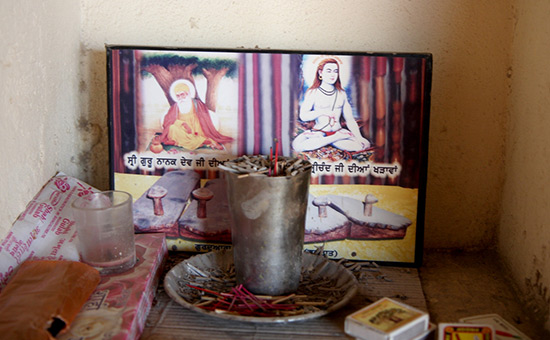 Guru Nanak and Baba Sri Chand, Lakhpat Gurudwara Kutch, Gujarat.
Guru Nanak and Baba Sri Chand, Lakhpat Gurudwara Kutch, Gujarat.
4. Who
are Udasis and Nirmalas?
The Udasi historically,
began with Baba
Siri Chand (son of Guru Nanak Dev and Mata Sulakhani Devi). Udasis are
known for their renunciatory outlook as against the mainstream Sikh belief in worldly
activity. Udasi establishments do not fall under the control of the Shiromani
Gurdwara Parbandhak Committee (SGPC).
Also read The
Udasi Tradition
On Nirmalas Dr
Satish K. Kapoor wrote
in South Asian Observer,
Toronto, “While at Paonta Sahib (Himachal Pradesh) where he composed most of
his writings, Guru Govind Singhji sent five of his disciples – Ganda Singh,
Karam Singh,Vir
Singh, Ram Singh and Saina Singh– investing them with the saffron attire of
ascetics, to Kashi (Varaṇasi)
in 1686, for learning Sanskrit and acquiring knowledge of classical Hindu
texts. The chosen Sikhs studied under Pandita Satyananda for about seven years
and acquired the quintessentials of ancient Sanskrit literature. After
returning to Anandpur Sahib (Punjab), birthplace of the Khalsa, they were
called Nirmalas, meaning pure and spotless. The Nirmalas keep long hair,
flowing beard, and wore turban but do not always undergo the Sikh baptismal
rites of the orthodox. They consider Vedanta as
most practical and sublime, and are sometime called Vedanti Sikhs.”
Bandai Sikhs are
followers of Banda Bahadur.
5. Who
are Nirankaris?
Dayal Das (born
1783 in a Malhotra Khatri family
of Peshawar, died 1855) belonged to this Hindu Sikh Community
(Khatris-Aroras-Baniyas who made atleast son a Kesadhari Sikh).1 The Nirankaris following is mainly
amongst non-Jaat Sikhs and Hindus of Arora Zargar and Kshatriya castes. 1 Pg. 124 It started as a reformist
movement.
“In the 1930s, Sant Nirankaris emerged as an offshoot of the
Nirankaris. While the original Nirankaris receded into the background, the Sant
Nirankaris continued to spread and grow, inviting the ire of orthodox Sikhs.” ThePrint here
“The
Nirankaris believe in the formless God-Nirankar-who can be reached through a
“God-realised soul” or “satguru”. Trouble began
in 1951, when Satguru Avtar Singh proclaimed himself a living guru in the
presence of the Adi Granth (the Sikh holy book, which is considered to be a
living Guru).” ThePrint Rivalry
between Sikhs and Nirankaris is nearly a century old
The cause of differences between orthodox Sikhism and Nirankaris are limited to the latter’s worship of gurus other than the ten gurus recognized by Sikhs. They also disapprove of militant Khalsa. 1 Pg.
125
According to this Indian Express report
, “The Nirankari
Mission, which is looked upon by many mainstream Sikhs as a heretic
cult, claims to be unaffiliated with any religion with an aim of uniting people
with God. The Nirankaris deny that Sikhs have any authority over them. In 1980,
then sect chief Satguru Gurbachan Singh was assassinated by a Sikh extremist at
the Foundation’s headquarters in Delhi.”
Also
read
Were
Backward Classes always suppressed in India?
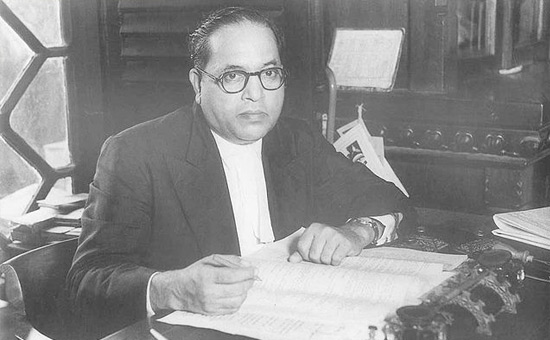 Ambedkar
Ambedkar
6. Dr Ambedkar wanted his followers to become Sikhs!
The Government of India Act 1935 introduced the term 'Scheduled Caste' (SC) for the depressed classes (DC) to which Ambedkar belonged. The word Scheduled
Tribe came to be used around 1950. In Tripura the former rulers are now S.T. so
a bust of Ambedkar is installed at their palace. The word Dalit come into prominence
since the 1990s and is said to be an American Church construct. There are
national commissions for the scheduled castes and backward classes but nowhere
is the word Dalit used.
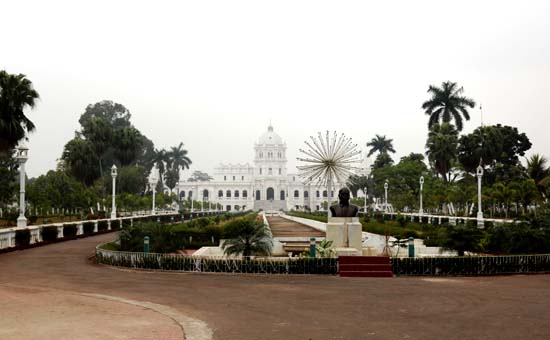 Ujjayanta Palace Agartala, Tripura.
Ujjayanta Palace Agartala, Tripura.
Today
there is a clamour to be declared SC/ST because of reservations in government
jobs etc., for e.g. the Dhangar community (to which Queen Ahilyabai Holkar belonged) want to be
declared a Scheduled Caste. New communities are declared SC/ST
invariably before elections when votes are sought.
Also
read
History
of the word Dalit
Ambedkar deputed
on 18/9/1936, a group of his followers to the Sikh Mission at Amritsar to study
the Sikh religion. They were a group of 13, none of whom was a scholar or a
first rate Ambedkarite. Ambedkar wished them success but had not asked them to
convert to Sikhism. In an excess of zeal those students went over to Sikhism
& did what their leader did not mean. They were coldly received in Bombay
and then sank into oblivion.
Prior to his
meeting the British in 1937, Ambedkar had consulted some German & other Europeans
jurists of repute as to the possibility of the DC retaining the reserved seats
in the Provincial Assemblies if DC became Sikhs for the Sikhs were granted
reserved seats only in Punjab. Later
the Sikh authorities & Ambedkar could not hit it off and so they parted. Source chapter
14 of Life and Mission of Dr Ambedkar by Dhananjay Keer
It is also
possible that the existing DC Sikhs told Dr Ambedkar of their ill-treatment. This might have influenced his decision. 3
Also after the
definition of who is a Sikh in the Gurudwaras Act 1925, the Depressed Classes
would post becoming Sikhs have to sport the 5 forms of Khalsa–turban, kada etc.
Would Ambedkar’s followers wear turbans and give up
Marathi for Punjabi!
It is also
possible that those who controlled SGPC then, realized that Ambedkar could take
control of SGPC if his followers, being large in number became Sikhs. Prof
Harish Puri adds, “Such is the evidence offered by Sardar Kapur Singh in his
well-known but controversial book, Saachi
Sakhi. According to him there was an apprehension that once the tall leader
Ambedkar became a Sikh with all his followers, none from the existing leaders
like Baldev Singh may be nominated to the Viceroy’s Executive Council as a
representative of the Sikh community.” 3
7. How
Jaat Sikhs became dominant in Punjab?
Initially, the Khalsa followers were mostly Jaats (were considered low caste then). Though others considered themselves Sikhs, they held back since they were not followers of Khalsa. The birth of Khalsa resulted in the rise of Jat power in Punjab. Khalsa was raised to fight Mughal oppression and persecution of Hindus and Sikhs (who then were considered part of the larger Hindu community).
Another view by
Prof Harish Puri is, “The large scale entry of the Jats by the time of the
Sixth Guru, tended to alter the caste equation in the Panth. The Jats
constituted the rural elite who dominated the rural Punjab. By the 18th century
the Jat constituency was preponderant among the constituent groups in the Panth
(McLeod 1975: 10).” 3
Also
read
Is
modern day Sikhism a colonial construct
Having experienced
the strength of Sikh opposition during the Anglo-Sikh wars and grateful for the
assistance received from Sikh princes during the Mutiny of 1857, the British
realized that Sikhs would be an effective buffer between Afghanistan and India.
Also
read
The
12 Sikh Misls of Punjab OR 12 Sikh MISLS
Therefore, the British reduced the number of Bengali soldiers (many of whom were involved in the 1857 Mutiny) and replaced them with loyal Sikhs and Punjabi Muslims. It however, insisted that only Kesadhari Sikhs could join the army i.e. those who sported the five k's. The enlistment of Sikhs rose steeply. Since it was mainly Jaat Sikhs who sported the five k's then, they were the biggest beneficiaries since soldiers were well paid, given agricultural land and pension.
In order to woo
the Jats, “The area specifically chosen for the Sikhs was a tract known as nili bar, irrigated by the Chenab canal. Colonization officers scoured Sikh villages in the districts of Amritsar, Ludhiana and Ferozpur to pick up the best farmers. The settlers were given heritable and inalienable rights of occupancy. The vast majority of Sikh colonists were Malwa Jats with a sprinkling on non-Jat agricultural tribes."1 Pg. 118
With time farmers (predominantly
Sikhs) prospered.
The British enforced rigid occupational boundaries by creating 'traditional agriculturists', 'martial races' and 'trading castes'. The Jats were classified as traditional agriculturists.
To retain
effective control over Punjab, the British accentuated the wedge between
land-owning Jats and non-agriculturists. Backward classes were declared a
non-agricultural caste. Thus, they could not own land and had to work as farm
labour.
The Punjab Land
Alienation Act of 1900 “enabled the government to retain its inflexible revenue
policies and continue to blame peasant proprietors’ misfortunes on Hindu
moneylenders. It was done to pacify the land owning classes and deflect a
rebellion, and to aggravate and exploit any tension that existed between Hindus
and Muslims to keep their political grip on Punjab. This piece of legislation
created a favoured, ‘dominant’ agriculturalist class at the expense of other
social groups. Here the ‘agriculturists’ were Muslim tribes and Sikh and Hindu
Jat zamindars, and the ‘non-agriculturists’ were Hindu Brahmins, Khatris and
Banias. The Act made tribe and caste the basis of land ownership.” 2
Thus,
Jaats became the biggest land owning community in Punjab.
Another reason for
rise in their power was that Jaats controlled SGPC since its inception in 1925.
Barring a couple every Chief Minister of Punjab, since the state was formed in
1966, has been a Jaat Sikh.
The caste divide
was created in the Indian Army too. A Jaat Sikh regiment and a Sikh Light
Infantry for Mazhabi Sikhs were created.
Thus, Jaat Sikhs became
socially dominant and politically powerful in Punjab.
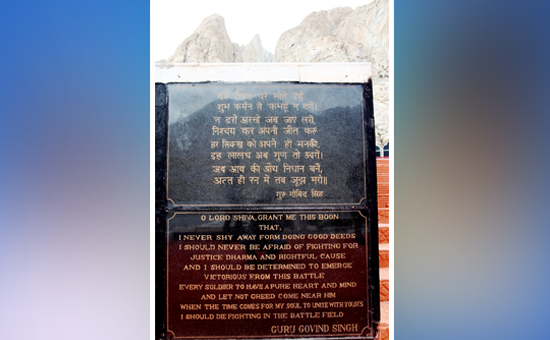 Guru Goving Singhji prayer to Shivji at Siachen War Memorial.
Guru Goving Singhji prayer to Shivji at Siachen War Memorial.
8. Who
is covered by the term Bhapas?
The Land
Alienation Act 1900 created a divide between Jaat and Khatri/Arora Sikhs such
that the latter are called “Bhapa”, a term used dismissively by Jaats to
describe some Khatris and others.
Former Chief
Minister and Jaat Sikh Pratap Singh Kairon referred to them as Bhapas
(brothers) a pejorative term for Sikhs of Brahmin, Khatri or Arora extraction.
This is despite all the ten Gurus being Khatris. 1 Pg 317
9. How
does one identify Brahmin Sikhs?
“Sikhs of Brahmin origin existed from the times
of Guru Nanak. If we see beyond the modern narrative then Pandit Hardyal
Pandha was the first one to recognize the divine light of Guru Nanak.” Current
distinctions did not exist then.
“Here is a short but not complete list of Brahmin
Sikh clans: Rishi, Sasan, Kala, Kalia, Chibber, Dutt, Rissam, Sudan, Pandha,
Vasudev, Issar, Dutta, Bhardwaj, Punj, Reen, Bali, Devgan, Joshi, Ramdev,
Raina, Tara, Vashisht.”
According to article
by H C Dutt in Dailyexcelsior the, “Mohyal-a clan of Saraswat
Brahmins separated their life style from other Brahmins by serving the society
with weapon in one hand and Vedas in other. The Sikh army was known for
many Mohyal warriors like Baba Praga Chhibber- the Bisham Pitama who with the
orders of Guru Har Govind fought and destroyed the large army of Shah Jahan.
Bhai Matti Dass Chibber was the Prime Minister of Guru Teg Bahadur who fought
with the army of Aurangzeb and was cut in two pieces with saw cutter by Mughals
on 9 November 1675 in Chandni Chowk, Delhi. His brother Bhai Satti Dass was
also burnt alive.”
Also read Contribution of Brahmins to Indian Society and Culture
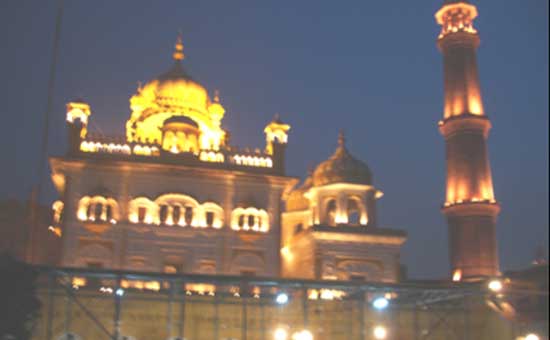 Maharaja Ranjit Singh Samadhi, Lahore
Maharaja Ranjit Singh Samadhi, Lahore
10. Who
are the Scheduled Castes in Sikhs?
They are Mazhabis,
Ramdasias, Sikhlighars, Kabirpanthis, Ravidasas etc.
Mazhabis are
karamchari/sweeper community. The Sikh Light Infantry in the Indian Army
consists of Mazhabhi Sikhs.
Ramdasias belong
to the Chamar (leather maker) community. The Bahujan Samaj
Party founder Kanshiram was a Ramdasia Sikh.
Giani Zail Singh
belonged to the carpenter community (of Ramgariya Sikhs). The Ramgariyas trace
their decent from Jassa Singh Ramgariya, who was a great leader, organiser and
warrior. Carpentars in say Uttar Pradesh, are not treated as scheduled castes but belong to the Vishwakarma community. Near Jaipur met a carpentar named Sharma who is a Jehangid Brahmin (see pic below)
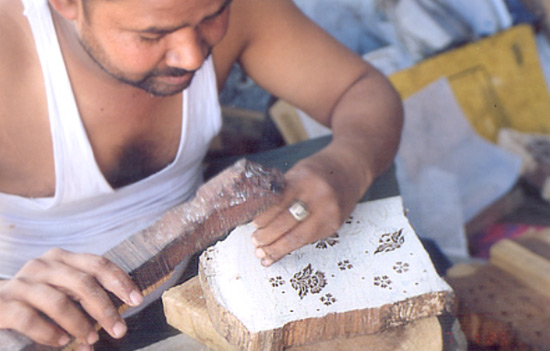 Brahmin Carpentar near Jaipur.
Brahmin Carpentar near Jaipur.
Prof Ronki Ram
wrote in ThePrint, “Those members who were mainly
from the weaving community, popularly known as Julahas, became Ramdasias
after conversion to Sikhism.” Source
This concept was conversion to another religion did not exist
till recently. Conversion is used when one adopts an Abrahmaic religion.
Dalit activist and advocate Dr S.L. Virdi wrote in ThePrint, “Dalit Sikhs and Jat Sikhs
have separate gurdwaras. The discrimination might not be as visible as in UP,
Bihar or Haryana in that Jaats may allow Dalits to enter gurdwaras but they
won’t allow them to make prasad,” he said. Source
Also read Survey paper by Prof Vishal Puri pg 17
Ad-harmis are a
sub-caste and known as Ravidassias. They follow Sant Ravidas (a chamar). Rajput Queen Meerabai was a follower of Sant Ravidas (rigid
western style distinctions amongst people do not work in India).
Also
read
Life
and Teachings of Sant Ravidas
According to as Indian Express report,
"An attack in 2009 during a religious congregation in Vienna, which the current chief of the Dera Sant Niranjan Das survived, but in which one of the sants was killed, became a watershed moment. In Varanasi, on the birth anniversary of Guru Ravidas in 2010, the Dera and its sants declared Ravidassia as a new religion.”
Ravidassias
believe in Ravidasia Dharm. It is a Panth,
like there have been many in India. “Dera Sachkhand or Dera
Ballan has emerged as a major centre for the articulation of the
Ravidassia identity in Punjab.”
According to a
Punjab based scholar, “They are considered pariahs in all matters. Sikhs
generally used the epithet Sant for Ravidas, denying him the status of Guru,
which they kept only for their own ten gurus. While Ravidasis take pride in
being chamars (as did their guru) Sikhs continue to consider chamars as low
caste. Inter-dining, intermarriage between two communities is still not
accepted, although the elite among them enjoys a better social status by virtue
of their political or economic power.”
Valmikis are found
amongst Hindus too. Ranghreta Sikhs are those who brought Guru Tegh Bahadur’s
head from Delhi to Anandpur. Sikhligars, found mainly in Maharashtra, are
Lohars who made Shastras/Arms for the Guru Govind Singhji. There are Rai,
Bazigar and Sansi Sikhs too.
The
British created this system of caste and sub-caste and Indians are trying to
justify their society based on that.
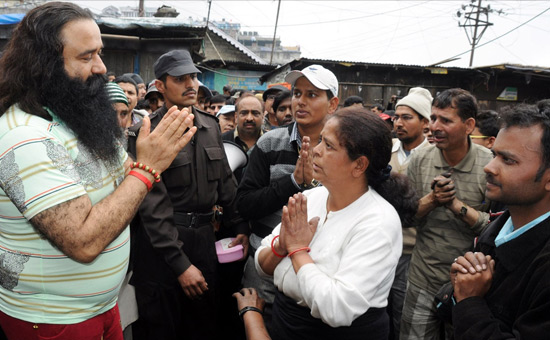 Dera Sacha Sauda Chief, old pic.
Dera Sacha Sauda Chief, old pic. 11. Why
have Deras become popular in Punjab and Haryana?
Dera refers to
places of worship associated with individual gurus.
The backward
classes and poor were left out of the prosperity ushered in by the Green
Revolution. The need for a support system and to be part of a larger community
was felt. It is this vacuum that deras like Sacha Sauda filled. They made the
poor feel secure, loved, provided a support system and gave them dignity.
According to a 2017 report in Chandigarh's Tribune the reasons for their popularity are four-fold .
One, identities of caste and religion cease to exist in the dera. Two, the humble
ranking of dera management. A state is divided into zones, with each zone
headed by a man called Bhangi Das. Three,
subsidised food and free rations. Four, many districts close to Sirsa in
Haryana are plagued by knee problems and cancer due to bad quality of water.
The dera provided free treatment.
Also
read
Why
Dera Sacha Suda draws followers
12. What
were the Gurus views on caste?
“If you were to go only by the Gurbani (the
words and writings of the ten Gurus of the Sikhs) there cannot be a caste
system in Sikhism. But this did not translate into practice,” said noted
scholar and subject expert Dr Harish Puri. Source ThePrint
It
must be known that neither do Hindu scriptures sanction caste?
Also
read
Rethinking
Caste-Why we cannot be one dimensional & Caste
is a Socio-Political Institution
What scriptures
say and the reality are different.
Also
read
Impact
of foreign invasions on Indian society & caste by R C Mazumdar
Note that the Panj
Pyare belonged to different caste. On 30 March 1699, at Anandpur, Govind
Singhji gave a stirring speech to the assembly about the need to protect their
spiritual and temporal rights. He then asked if anyone would offer his head in
the services of God, Truth and Religion. The five who came forward were Dayaram
a Khatri from Lahore, Dharamdas a Jat from Hastinapur near Delhi, Sahib Chand a
barber from Bidar in Karnataka, Himmat Chand Kahar, a water carrier from Puri
in Odisha and Mohkam Chand Chihimba from Dwarka in Gujarat.
Prof Harish Puri
wrote, “It was no problem that the Sikhs who were distinguished from Hindus (Hum Hindu Nahin), largely because they
did not believe in Hindu caste system, now considered that such a distinction
between the two religious communities was itself a discrimination against the
Sikhs. The Sikh leaders “promoted constitutional provisions for the Sikh society
which were an insult to Guru Nanak’s egalitarian principles.” 3
Utmost care is
taken in sharing history. While we can have differing views, in case of any
errors please mail with reference of source documents.
References
1. A History of
Sikhs, Volume II by Khushwant Singh.
2. Dowry Murder:
The Imperial origins of a Cultural Crime by Veena Talwar Oldenburg.
3. The Scheduled
Castes in the Sikh Community – A Historical Perspective by Prof Harish K Puri.
[First published in Economic & Political Weekly (28 June 2003) and was then
included in the author’s edited volume on Dalits in Regional Context (2004)
4. Hinduism: The
Faith Eternal by Dr. Satish K Kapoor.
Also
read
1. The myth of
a Castless Sikh Society by Prof Ronki Ram 2007 paper
2. The
Historical role of Caste amongst Sikhs
3. What
happened during the Khalistani Movement
Simridhi Makhija contributed to this article.
Disclosure – The author
is a Punjabi Khatri who takes equal pride in the karmas of Shivaji Maharaj and
Guru Govind Singhji.